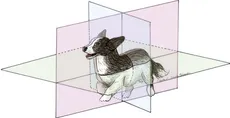Basics of Word Structure
Before we embark on the contents of this chapter, allow me to explain a few things. Refer to the Chapter 1 introductory table in Appendix C, for a moment. It probably looks daunting to you, but don’t panic. I don’t expect you to memorize or to fully understand all of the terminology listed in that table right now. My job is to guide your learning. I hope to do that in a logical manner, using numerous examples and repetition. I will present each of the terms listed in the introductory table in context to aid your understanding. Let’s start slowly using a few directional terms to explain the basic structure of medical terms in general. Yes, some of the terms listed are big and foreign. Yet they are just words … some are really big words. Each one can be broken down into smaller digestible parts. Recognition of the parts makes defining, understanding, and using the terms much easier. Words, including medical terms, can be likened to trains. They are each built of important parts. Without each of the necessary parts, the train can’t deliver precious cargo and words can’t deliver appropriate meanings.
Do not, I repeat—do not—skip over the following information. What follows is essential to your understanding of medical terminology. You must grasp the function of each type of word part (i.e., root word, prefix, suffix, and combining vowel) before we can discuss the directional and imaging terminology presented in this chapter.
Root Word
The root word is the foundation of any word. It gives substance and meaning to a word, much like each boxcar and tank car in a train give it mass and value. Like a train’s cars, root words come in a variety of sizes, “shapes,” and “colors,” each holding a special cargo (i.e., meaning) within.
It is from the root word that most of the meaning of a given word is derived. In general, words may contain one or multiple root words. For example, the word football contains two root words (root 1 = foot, root 2 = ball). Similarly, medical terms may contain one, two, or many root words. But be not ye anxious! Don’t be alarmed by the length and complexity of some medical terms. Once you begin to recognize various root words (just like brand names and logos on a train’s cars), you will begin to understand and “unpack” the overall meanings of medical terms.
There are many examples of root words throughout this chapter and book. In Appendix C, the root words and their corresponding meaning are shown in bold. Let’s play with a couple of those root word examples. In the directional term cranial [crani(o)- head + -al pertaining to], the root word is crani(o)- meaning “head.” It refers to the body part that we call the head. As you begin to learn the directional terms in this chapter, you will find that many of them reference a particular aspect of the body or body part. Even if you know very little about anatomy yet, you’ll understand many directional terms because of their commonly referenced root words. For instance, everyone knows a head [crani(o)-] from a tail [caud(o)-]. So, it is easy to figure out, directionally, where to look for cranial versus caudal [caud(o)- tail + -al referring to] injuries on an animal or on a radiograph (or x-ray).
Prefix
The prefix can be likened to the train’s engine with its whistle. The engine goes before the boxcars, and its whistle announces the approaching train. Likewise, a prefix goes before a root word and announces that a wealth of meaning is coming. (Note: in Appendix C, prefixes and their corresponding meaning are shown in italics.)
Do prefixes have much meaning? Yes, they do, but they cannot stand alone. Once again, let’s think about this in terms of a train. Is an engine the tr...


